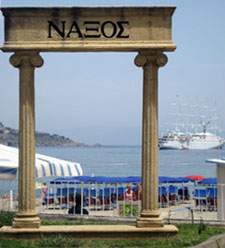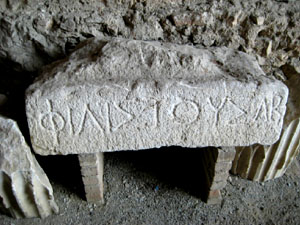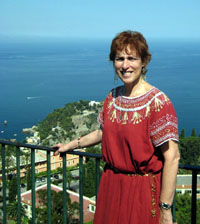 |
||||
|
Hellenism in Giardini-Naxos
|
||||
The first Greek colony in Sicily was in Naxos,” said Dr. Gaetano Cipolla. “We are Greek-Sicilians.” This was my introduction to a fabulous two day stay in Giardini-Naxos on Sicily’s Ionian sea coast, during a recent Arba Sicula Society tour. Our stay began in June at the all inclusive hotel Caesar’s Palace. A Greek flag was prominently displayed at the entrance with other international flags. Greek columns and vases were displayed, next to oleanders. Rosario Scandurra, owner of the Caesar Palace Gift Shop, said “we love our American clients. Greeks are like family for us. Naxos in Greece has a special relationship to us. We are twins and have mutual relations.” A four foot tall Greek vase decorates the entrance to his shop. |
 Rosario Scandurra and his wife showing his shop items |
|||
Taormina was on everyone’s program for the next two days. It is the main Sicilian resort. Our group entered the famous theater, that was a highlight of our tour. We had a group photo on the theater’s balcony, overlooking the Ionian Sea. The Taormina theater is the largest in Sicily after Syracuse. It is one of the finest examples of theater building of the Hellenistic and Roman periods. Its acoustics are unique. From the top of the Theater stairs, we had an extraordinary view dominated by Mount Aetna. The theater was built in the 3rd century B.C. by the tyrant Hieron II of Syracuse. Abut 100,000 cubic meters of limestone rock were removed from the site. In the Art and History of Sicily by Bonechi, “the ruins of this excellently preserved . That evening during disco hour, Greek dance music was played for an Athenian tour group. Kalamatiano and Ikarian folk dances were heard throughout the Sicilian hotel. Persons of all nationalities danced Greek in this island that is part of Italy. That week there were many tourists from Greece. One young woman, who spoke English, said her parents were from Sparta. Many had a Greek relative. Mary Summon Scoffer’s grandmother lived in the Greek area of Sicily known as Piazza de Gregi (Plane of the Greeks). “My father’s older sister read the Greek newspaper each day.” she said. “Once when I visited her in New Jersey, she said don’t forget we are blue bloods.” |
||||
The next morning, I entered the Ancient Naxos excavation site. Some stone ruins of walls and houses were seen in lemon groves with Mount Aetna rumbling in the background. The view is simply breathtaking The museum is small. Many of the artifacts were purchased by Paolo Orsi, the greatest twentieth century Sicilian archaeologist. It is an undeveloped site under excavation. Thuycidides stated that the foundation of Naxos was established in 734 B.C. “The first of the Greeks to organize an overseas expedition to Sicily were the Chalcidians of Euboea. Led by the founder Thoukles, they founded Naxos and erected the altar to Apollo Archegetes, which can still be seen outside the walls,” said Thuycidides. |
 Taormina theater |
|||
Naxos is one of the largest Cycladic islands. Historical and archaeological evidence shows that settlers from Naxos took part in the colonization. The colony’s name indicates that the islanders played a significant role. Today, Naxos in Greece is the sister city of Giardini-Naxos in Sicily”, said Lefteris Kitsos of Bayside, New York. “The Hellenic Cultural Center in Astoria had a program on both areas and educated us.” The city’s history ended in 403 B.C. when Dionysius I of Syracuse destroyed the city. According to our tour guide Diana Mazza, “the Greek colonies were constantly at war with each other, destroying settlements.” “When Naxos was destroyed by Dionisios of Syracuse, the inhabitants (whowere Greek) fled intothe mountains and settled in Taormina and Dr. Cipolla’s town of Francavilla. |
||||
| One can wander through the streets of Giardini-Naxos with the English language. Buying liters of water and food from a local supermarket was a learning experience in how to save money. Our hotel gave us free passes with a table and chairs to the local beach. The swimming area of Giardini-Naxos, bordering the Ionian Sea, is in postcards and books. The rocky coastline reminds one of Eastern Long Island “In the new lands, the Greeks met and sometimes clashed with people who already had a developed political, social and cultural structure,” said Lorena Jannelli in his book The Greeks in Sicily. “The superior organization of the new arrivals generally guaranteed victory for Greeks on both political and military levels in their confrontations with the native races. Association led to a transference of intellectual ideas. The use of slave labor, mixed marriages and the employment of mercenaries are some aspects of this social mobility. It gave rise to a new culture.” |
 Naxos-Giardini’s famous beach, that is one of the best in Sicily |
|||
The alphabet was introduced to Sicily by the Phoenicians from Lebanon,” said assistant tour guide Sara Basile. “it was mostly consonants. The Greeks arrived and introduced the vowels. |
||||
| Diana Mazza, our tour guide, added “the Greeks came to Sicily because it was rich. When they reached here they called it a garden (giardini in Italian). They came from a poor land. When we had the Greeks here, the first laws were written by Caronus (look up) of Catania. Honor and respect were the laws to live by. Criminals were degraded by dressing them in women’s clothing for three days. Gradually, the Greeks of Sicily began marrying the natives and became Sicilioti.” Internet links: |
 Greek writing on the theater’s stone |
|||
|
||||
|
(Posting date 07 February 2010) HCS encourages readers to view other articles and releases in our permanent, extensive archives at the URL http://www.helleniccomserve.com/contents.html. |
||||
|
||||
|
2000 © Hellenic Communication Service, L.L.C. All Rights Reserved.
http://www.HellenicComServe.com |
||||

